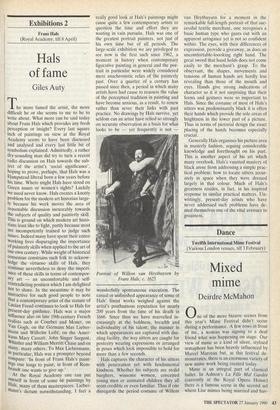Exhibitions 2
Frans HaIs (Royal Academy, till S April)
Hals of fame
Giles Auty
The more famed the artist, the more difficult he or she seems to me to be to write about. What more can be said today about Frans Hals which provides any fresh perception or insight? Every last square inch of paintings on view at the Royal Academy seems to have been discussed and analysed and every last little bit of symbolism explained. Admittedly, a rather dry-sounding man did try to turn a recent radio discussion on Hals towards the sub- ject of the artist's 'social significance', hoping to prove, perhaps, that Hals was a Hampstead liberal born a few years before his time. Where might Hals have stood on Green issues or women's rights? Luckily we need never know. Hals creates a knotty problem for the modern art historian large- ly because his work moves the area of reasonable discussion inexorably towards the subjects of quality and painterly skill. This is ground on which modern art histo- rians least like to fight, partly because most are incompetently trained to judge such issues. Indeed many have spent their entire working lives disparaging the importance of painterly skills when applied to the art of our own century. While weight of historical consensus constrains such folk to acknow- ledge the virtuoso skills of Hals, they continue nevertheless to deny the import- ance of these skills in terms of contempor- ary art --- an uncomfortable and self- contradicting position which I am delighted not to share. In the meantime it may be instructive for such good people to note that a contemporary artist of the stature of Lucian Freud continues to look to Hals for present-day guidance. Hats was a major influence also on late 19th-century French realists such as Courbet and Monet, on Van Gogh, on •the Germans Max Lieber- ann and Wilhelm Leibl, on the Amer- icans Mary Cassatt, John Singer Sargent, Whistler and William Merritt Chase and on many, many others. To Max Liebermann , In particular, Hals was a prompter beyond compare: 'In front of Frans Hals's paint- ings one longs to paint; in front of Rem- brandt one wants to give up.'
At the Royal Academy one can put oneself in front of some 66 paintings by Hats, many of them masterpieces. Lieber- Inaun's dictum notwithstanding, I feel a
really good look at Hals's paintings might cause quite a few contemporary artists to question the time and effort they are wasting in vain pursuits. Hals was one of the greatest portrait painters, not just of his own time but of all periods. The large-scale exhibition we are privileged to see now is the first such since 1962, a moment in history when contemporary figurative painting in general and the por- trait in particular were widely considered mere anachronistic relics of the painterly past. Over a quarter of a century has passed since then, a period in which many artists have had cause to reassess the value of the perceptual tradition in painting and have become anxious, as a result, to renew rather than sever their links with past practice. No drawings by Hals survive, yet seldom can an artist have relied so strongly on accurate observation as a basis for what looks to be — yet frequently is not — Portrait of Willem van Heythuysen by Frans Hats,' c. 1625 wonderfully spontaneous execution. The casual or unfinished appearance of some of Hats' finest works weighed against the artist's posthumous reputation for nearly 200 years from the time of his death in 1666. Since then we have marvelled in- creasingly at the boldness, breadth and individuality of his talent; the manner in which appearances are captured with daz- zling facility, the way sitters are caught for posterity wearing expressions or arranged in poses which look impossible to hold for more than a few seconds.
Hals captures the character of his sitters with penetration yet with fundamental kindness. Whether his subjects are stolid burghers, winsome women, conceited young men or animated children they all seem credible or even familiar. Thus if one disregards the period costume of Willem van Heythuysen for a moment in the remarkable full-length portrait of that suc- cessful textile merchant, one recognises a basic human type who gazes out with an apparent arrogance yet is not so confident within. The eyes, with their differences of expression, provide a giveaway, as does an uncomfortable-l000king right hand. The great 'sword that hand holds does not come easily to the merchant's grasp. To the observant, the shapes, movements and tensions of human hands are hardly less revealing than those of the mouth and eyes. Hands give strong indications of character so it it not surprising that their forms and gestures were so important to Hals. Since the costume of most of Hals's sitters was predominantly black it is often their hands which provide the sole areas of brightness in the lower part of a picture. Thus in terms of pictorial design the exact placing of the hands becomes especially crucial.
Generally Hals organises his picture area in masterly fashion, arguing considerable knowledge and forethought on his part. This is another aspect of his art which many overlook. Hals's vaunted mastery of black arose from addressing a simple prac- tical problem: how to locate sitters accur- ately in space when they were dressed largely in that colour. Much of Hals's greatness resides, in fact, in his inspired response to similar practical matters. Un- wittingly, present-day artists who have never addressed such problems have der nied themselves one of the vital avenues to greatness.


























































 Previous page
Previous page